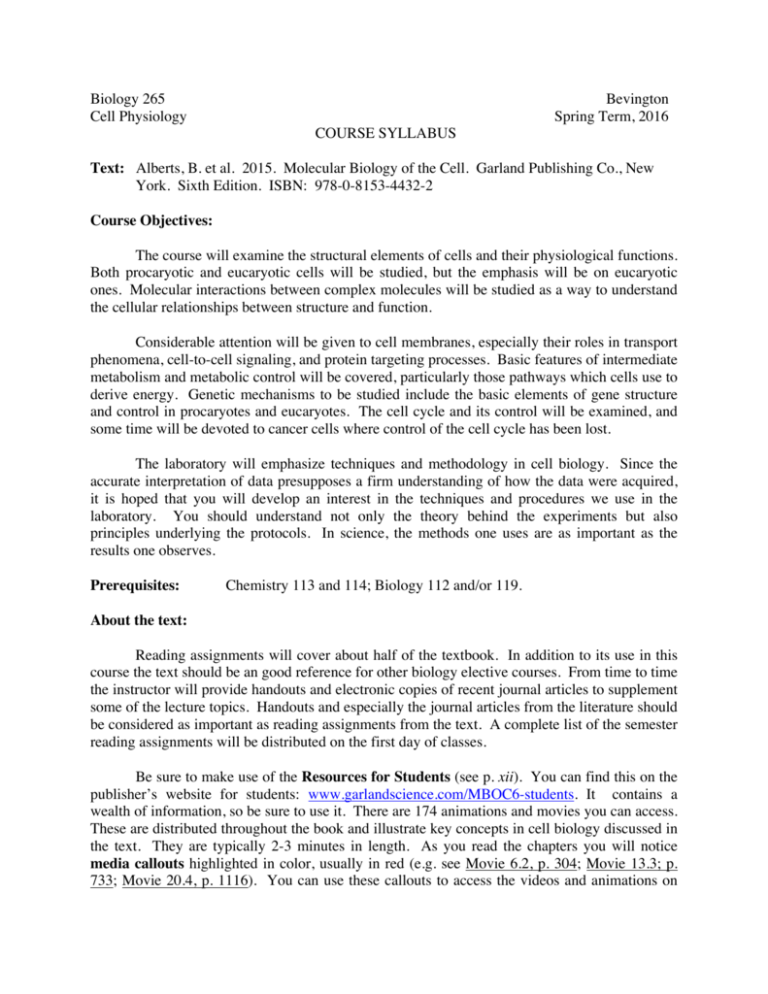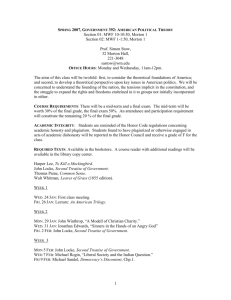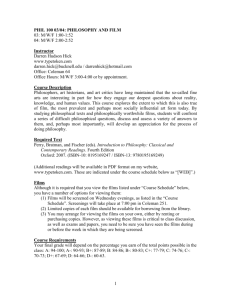BIOL 265
advertisement

Biology 265 Cell Physiology Bevington Spring Term, 2016 COURSE SYLLABUS Text: Alberts, B. et al. 2015. Molecular Biology of the Cell. Garland Publishing Co., New York. Sixth Edition. ISBN: 978-0-8153-4432-2 Course Objectives: The course will examine the structural elements of cells and their physiological functions. Both procaryotic and eucaryotic cells will be studied, but the emphasis will be on eucaryotic ones. Molecular interactions between complex molecules will be studied as a way to understand the cellular relationships between structure and function. Considerable attention will be given to cell membranes, especially their roles in transport phenomena, cell-to-cell signaling, and protein targeting processes. Basic features of intermediate metabolism and metabolic control will be covered, particularly those pathways which cells use to derive energy. Genetic mechanisms to be studied include the basic elements of gene structure and control in procaryotes and eucaryotes. The cell cycle and its control will be examined, and some time will be devoted to cancer cells where control of the cell cycle has been lost. The laboratory will emphasize techniques and methodology in cell biology. Since the accurate interpretation of data presupposes a firm understanding of how the data were acquired, it is hoped that you will develop an interest in the techniques and procedures we use in the laboratory. You should understand not only the theory behind the experiments but also principles underlying the protocols. In science, the methods one uses are as important as the results one observes. Prerequisites: Chemistry 113 and 114; Biology 112 and/or 119. About the text: Reading assignments will cover about half of the textbook. In addition to its use in this course the text should be an good reference for other biology elective courses. From time to time the instructor will provide handouts and electronic copies of recent journal articles to supplement some of the lecture topics. Handouts and especially the journal articles from the literature should be considered as important as reading assignments from the text. A complete list of the semester reading assignments will be distributed on the first day of classes. Be sure to make use of the Resources for Students (see p. xii). You can find this on the publisher’s website for students: www.garlandscience.com/MBOC6-students. It contains a wealth of information, so be sure to use it. There are 174 animations and movies you can access. These are distributed throughout the book and illustrate key concepts in cell biology discussed in the text. They are typically 2-3 minutes in length. As you read the chapters you will notice media callouts highlighted in color, usually in red (e.g. see Movie 6.2, p. 304; Movie 13.3; p. 733; Movie 20.4, p. 1116). You can use these callouts to access the videos and animations on 2 the publisher’s website from your computer. There are also slides and flashcards on the website you can use to study and for review. Laboratory experiments: There is no laboratory manual for the course. Laboratory experiments come from handouts developed by the instructor. These will be distributed during the first class meeting. Be sure to read the laboratory experiments and familiarize yourself with the protocols before you come to laboratory. Grading: Point Value Percentage of Final Grade Three hour exams (180 points each) 540 54% Three lab quizzes (65 points each) 195 19.5% 265 _____ 26.5% _____ 1000 100% Item One final exam (comprehensive) Students who wish to request accommodations in this class for a disability should contact the Academic Support Center, located in the lower level of Monocacy Hall, or by calling 610-861-1401. Accommodations cannot be provided until authorization is received from the Academic Support Center. 3 OUTLINE OF THE LECTURE SEQUENCE 1 Introduction: scope and objectives of the course A brief review of cell structure Fractionation of cellular organelles – How to take a cell apart. Molecules in cells Chemical bonds and molecular interactions Important characteristics of water The major classes of small molecules (sugars, amino acids, fatty acids, and nucleotides) Nucleic acids Proteins Structure Protein functions and factors which affect function Assembly and turnover Enzymes: kinetics and factors affecting catalytic action Lipids: triglycerides and phospholipids How cells synthesize proteins Basic mechanisms of the process RNA synthesis, RNA processing, RNA export from the nucleus Molecular chaperones and protein folding Ubiquitin, proteasomes, and protein destruction Transcriptional control of gene expression Posttranscriptional control Cell growth and control of the cell cycle The mechanics of cell division* Cancer cells and loss of control of the cell cycle Cellular membranes Architecture Transport phenomena Cellular compartmentalization and protein sorting: How are proteins targeted to and from the nucleus, mitochondria, chloroplasts, and peroxisomes? 1 The lecture topic marked with an asterisk (*) may be abbreviated or eliminated to allow more time for another topic. 4 Endoplasmic reticulum Signal hypothesis and the role of SRPs in directing proteins to the ER Vectorial transport of proteins into the ER lumen Protein glycosylation How the ER deals with improperly folded proteins Synthesis of membrane lipids Vesicular traffic: How do vesicles arrive at the correct destinations within a eucaryotic cell? The Golgi complex Structure and origin Posttranslational modification of secretory, membrane, and glycoproteins Sorting, packaging, and targeting of proteins from the Golgi Lysosomes and cellular digestion Receptor-mediated endocytosis. Exocytosis and secretion Cell signaling General principles Signaling via G-protein linked cell surface receptors Cell metabolism Overview and general concepts The major metabolic pathways of cells How cells regulate metabolism Glyolysis in the cytoplasm The mitochondrion Oxidation of pyruvate and fatty acids in the citric acid cycle Electron transport, proton-motive force, and oxidative phosphorylation Metabolic regulation of glycolysis and the citric acid cycle The Glyoxylate cycle and lipid metabolism Pentose shunt (the pentose phosphate pathway) The chloroplast and photosynthesis Photochemical events and the light reactions Photolysis, electron transport, and photophosphorylation C3 and C4 metabolism 5 TARGET DATES FOR LECTURE TOPICS Mon. 18 Jan. Wed. 20 Jan. Fri. 22 Jan. Introduction, course objectives, begin review of cell structure Review of cell structure Complete review of cell structure; fractionation of cellular organelles; begin chemical bonds and molecular interactions Mon. 25 Jan. Wed. 27 Jan Fri. 29 Jan. Properties of water, small molecules; begin nucleic acids Nucleic acids Proteins Mon. Wed. Fri. Proteins 1st Quiz (labs 1 & 2); proteins Complete proteins, begin enzymes 1 Feb. 3 Feb. 5 Feb. Mon. 8 Feb. Wed. 10 Feb. Fri. 12 Feb. Enzymes Protein synthesis Protein synthesis Mon. 15 Feb. Wed. 17 Feb. Fri. 19 Feb. FIRST HOUR EXAM Protein synthesis Control of gene expression Mon. 22 Feb. Wed. 24 Feb. Fri. 26 Feb. Control of gene expression Control of gene expression Cell cycle Mon. 29 Feb. Wed. 2 Mar. Fri. 4 Mar. Cell cycle 2nd Quiz (labs 3,4, 5 & 6); begin cancer cells Cancer cells (MID TERM) Sat. 5 Mar. - Sun. 13 Mar. SPRING RECESS Mon. 14 Mar. Wed. 16 Mar. Fri. 18 Mar. Cancer cells; begin cell membranes Cellular membranes Cellular membranes Mon. 21 Mar. Wed. 23 Mar. Targeting proteins to the nucleus, mitochondria, and chloroplasts SECOND HOUR EXAM Fri. 25 Mar. - Sun. 27 Mar. Mon. 28 Mar. Wed. 30 Mar. Fri. 1 Apr. EASTER RECESS Endoplasmic reticulum Endoplasmic reticulum Complete ER; begin Golgi 6 Mon. Wed. Fri. 4 Apr. 6 Apr. 8 Apr. Golgi 3rd Quiz (labs 7,8, & 9); Golgi Lysosomes; receptor-mediated endocytosis Mon. 11 Apr. Wed. 13 Apr. Fri. 15 Apr. An overview of metabolism, glycolysis Glycolysis Glycolysis Mon. 18 Apr. Wed. 20 Apr. Fri. 22 Apr. TCA cycle THIRD HOUR EXAM TCA cycle and its control, cytochrome system, oxidative phosphorylation Mon. 25 Apr. Wed. 27 Apr. Fri. 29 Apr. Pentose phosphate pathway and the glyoxylate cycle Review and comparisons: respiratory metabolism and photosynthesis Last Class Mon. 2 May. - Sat. 7 May Wed. 4 May. Final Exams Final exam for this course, 2 hours (8:00 am) 7 LABORATORY SCHEDULE Lab. No. Dates Topics 1. 19, 20 Jan. Laboratory orientation: protocols, preparing solutions and making dilutions, pipeting, pipeting devices, and safety precautions 2. 26, 27 Jan. Spectrophotometry: Beer’s Law, use of the B&L Spectronic 20 spectrophotometers Constructing absorption curves for cytochrome c, DCPIP, and anthocyanin pigments from red cabbage at different pHs 3. 2, 3 Feb. Spectrophotometric assays for protein (Bradford and bicinchoninic acid methods) 4. 9, 10 Feb. Cell growth: growth kinetics in Enterobacter aerogenes 1. Determining generation time 2. Effects of temperature, chloramphenicol, peptone, and the amino acid analogue p-fluorophenylalanine 5. 16, 17 Feb. Enzyme assay: acid phosphatase 1. Effect of substrate concentration 2. Effect of phosphate ion 6. 23, 24 Feb. Estimation of specific activity of extracted acid phosphatase 7. 1, 2 Mar. Isolating an organelle: 1. Mitochondria from cauliflower florets 2. Enzyme assay for succinic dehydrogenase and/or malate dehydrogenase Sat. 5 Mar. - Sun. 13 Mar. Spring Recess 8. 15, 16 Mar. Factors affecting membrane permeability 9. 22, 23 Mar. Hill reaction and the Emerson enhancement effect in isolated chloroplasts Fri. 25 Mar. - Sun. 27 Mar. 10. 29, 30 Mar. 11. 5, 6 Apr. Easter Recess Tyrosinase Effects of ultraviolet radiation on Paramecium, Tetrahymena, and Euglena 8 12. 12, 13 Apr. Labeling patterns in glycolysis and the TCA 13. 19, 20 Apr. When does carbon from hexose sugars flow into the pentose phosphate pathway instead of glycolysis and why? 14. 26, 27 Apr. Open SUMMARY OF DATES FOR QUIZZES AND EXAMS Wed. 3 Feb. Mon. 15 Feb. Wed. 2 Mar. Wed. 23 Mar. Wed. 6 Apr. Wed. 20 Apr. First lab quiz (No’s. 1 and 2) FIRST HOUR EXAM Second lab quiz (No’s. 3, 4, 5 and 6 ) SECOND HOUR EXAM Third lab quiz (No’s 7, 8, 9 and 10) THIRD HOUR EXAM








